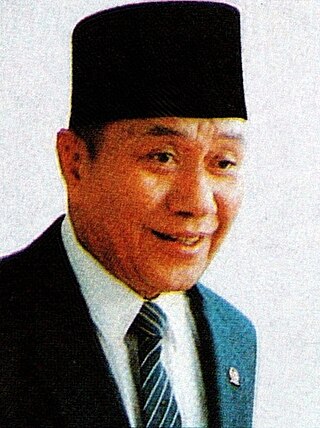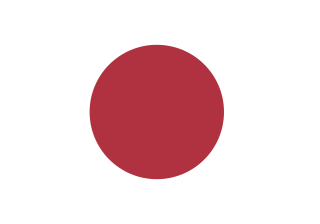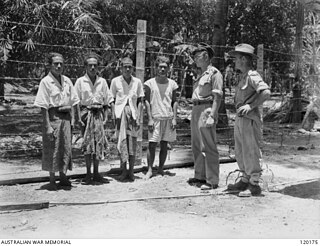
The Indonesian Army is the land branch of the Indonesian National Armed Forces. It has an estimated strength of 300,400 active personnel. The history of the Indonesian Army has its roots in 1945 when the Tentara Keamanan Rakyat (TKR) "People's Security Army" first emerged as a paramilitary and police corps.
Rōmusha (労務者), is a Japanese language word for a "paid conscripted laborer." In English, it usually refers to non-Japanese who were forced to work for the Japanese military during World War II. The U.S. Library of Congress estimates that in Java, between 4 and 10 million rōmushas were forced to work by the Japanese military during the Japanese occupation of the Dutch East Indies during World War II, many of whom experienced harsh conditions and either died or were stranded far from home. With the term imprecisely defined by both the Japanese and the Allies, estimates of the total number of rōmushas may include the kinrōhōshi, native auxiliary forces, and voluntary transmigrants to other islands in Indonesia.

General (Ret.) Amir Machmud was an Indonesian military general who was an eyewitness to the signing of the Supersemar document transferring power from President Sukarno to General Suharto.

This is the timeline of Indonesian National Revolution.

The Defenders of the Homeland was a volunteer army established on 3 October 1943 in the Dutch East Indies by the occupying Japanese. The Japanese intended PETA to assist their forces in opposing a possible invasion by the Allies. By the end of World War II, there were a total of 69 battalions in Java, Madura, and Bali and Sumatra. On 17 August 1945, the day after the Proclamation of Indonesian Independence, the Japanese ordered the PETA daidan to surrender and hand over their weapons, which most of them did. Indonesia's inaugural President, Sukarno, supported the dissolution rather than turning the organisation into a national army as he feared allegations of collaboration had he allowed a Japanese-created militia to continue to exist.

In Dutch historiography, Bersiap refers to the violent and chaotic beginning of the Indonesian National Revolution following the end of World War II in Asia. In Indonesia, the term Berdaulat ("Sovereign") is also used for this transitional period. It began after Sukarno's proclamation of Indonesian Independence on 17 August 1945 and culminated during the power vacuum between the withdrawal of Japanese occupational forces and the gradual buildup of a British military presence, before the official handover to a Dutch military presence in March 1946.

General Raden Oerip Soemohardjo was an Indonesian general, the first chief of general staff of the Indonesian National Armed Forces, and acting Commander of the Indonesian National Armed Forces. He received several awards from the Indonesian government, including the title National Hero of Indonesia in 1964.

Sudirman was an Indonesian military officer and revolutionary during the Indonesian National Revolution and the first commander of the Indonesian National Armed Forces.
Preman is a term for Indonesian organized crime groups, encompassing street level criminals up through crime bosses. Premans are often perceived negatively throughout Indonesian society due to associations with violence and criminality. This root word is derived from a term which describes the "confluence of state power and criminality". However, organized crime in Indonesia has a more enduring and complicated history, as the confluence of crime syndicates with perceived legitimate political authority has a history extending as far back as the Mataram Kingdom. While associated with brigandage and theft, Indonesian crime syndicates have periodically acted as enforcers to maintain authority and order. The roles of the jago or jawara were particularly important during the Indonesian Revolution, as they often adopted political roles that helped consolidating the power of local authorities. Despite their significance to Indonesian history, syndicates are universally marginalized due to associations with violence and social illegitimacy.

The PETA revolt in Blitar was an anti-occupation revolt in present-day Indonesia, which took place on 14 February 1945 by the PETA daidan (battalion) in Blitar. This revolt was widely known as the first major uprising of local armies in Indonesia during the Japanese occupation. The revolt ended unsuccessfully; most of the rebels abandoned the attack, or were captured or killed by the Japanese. Nevertheless, the government of Indonesia acknowledged the revolt as a meaningful revolution.
The following is an order of battle of the Indonesian National Armed Forces as of 8 January 1946, after the then People's Security Armed Forces was transformed into the People's Safety Armed Forces by Presidential Resolution #2/1946.

The People's Security Agency, commonly abbreviated as BKR, was an Indonesian government agency established to undertake the task of maintaining security together with the people and the state offices. The BKR was formed by the Preparatory Committee for Indonesian Independence (PPKI) in its session on 22 August 1945 and announced by President Sukarno on the next day.

Seinendan was a youth organization formed on 9 March 1943 by the Imperial Japanese Army in the occupied Dutch East Indies. The purpose of the Seinendan organization was ostensibly to educate and train young people so that they could defend their homeland from imperialism. Its real purpose, however, was to prepare the Indonesian youths to assist the Japanese military against the expected Allied invasion of the Indonesian archipelago. The organization was considered paramilitary in nature and under the leadership of the occupation authorities. The requirements to become a member proved not too strict and soon there were 35,500 youth members aged 14 to 25 years old from all over Java. This number had grown to about 500,000 youths by the time Japan surrendered.
Keibōdan was an organization formed by the Empire of Japan in the occupied Dutch East Indies during World War II. Indonesian names for the organization were Barisan Pembantu Polisi and Laskar Penjaga Keamanan rakyat. The Keibōdan was formed on 29 April 1943, alongside the Seinendan, and led by the occupation authorities. The purpose of the Keibōdan was to assist the Japanese-controlled police for the duration of the occupation. In addition, the organization ostensibly provided paramilitary training to Indonesian youths to defend their homeland from imperialism. In reality, the Japanese intended the Keibōdan to be a reserve of troops during its war against the Allies. In Sumatra the organization was known as Bōgodan, while in Kalimantan it was better known as Sameo Konen Hokokudan. Among Chinese Indonesians formed a variation of Keibōdan with the name Kakyō Keibōtai. In charge of the Keibōdan were the Keimubu, who in turn reported to the Gunseibu. The Keibōdan groups consisted of youths aged 20 to 35 years and numbered approximately one million members. Serving as an auxiliary police force, it was authorized to regulate traffic and maintain order and security in the villages.
The Jibakutai were suicide attack units formed during the Japanese occupation of the Dutch East Indies of World War II. The corps was created on 8 December 1944, coinciding with the third anniversary of the "Greater East Asia War". The Jibakutai numbered c. 50,000 members who received training in Cibarusah, Bogor Regency for two months, supervised by Imperial Japanese Army Captain Yanagawa.
The Hōkōkai were associations formed by the Empire of Japan on 8 January 1944 to replace the Pusat Tenaga Rakyat during the Japanese occupation of the Dutch East Indies in World War II. The original incarnation of the Hōkōkai was formed on Java by the commander of the Sixteenth Army, General Kumakichi Harada, after the Japanese realized that the Putera had exacerbated the desire for Indonesian independence rather than promote Japan's local interests in its war against the Allies.

Before and during World War II, the Empire of Japan created a number of puppet states that played a noticeable role in the war by collaborating with Imperial Japan. With promises of "Asia for the Asiatics" cooperating in a Greater East Asia Co-Prosperity Sphere, Japan also sponsored or collaborated with parts of nationalist movements in several Asian countries colonised by European empires, the Soviet Union, and the United States. The Japanese recruited volunteers from several occupied regions and also from among Allied prisoners-of-war.

Hizbullah or Laskar Hizbullah was a laskar perjuang that was active during the Indonesian war of independence. Hizbullah was formed on 8 December 1944 by the Japanese occupation government under the name of Kaikyō Seinen Teishintai. Hizbullah was established as a reserve force for the Defenders of the Homeland (PETA) with members consisting of Muslim youths. Unlike PETA, which was under the command of the Imperial Japanese Army, Hizbullah's command lay with the Masyumi Party. Therefore, Hizbullah was not disbanded like PETA when Japan surrendered to the Allies in August 1945. After the Indonesian proclamation of independence, Hizbullah fought to defend the sovereignty of the newly established Indonesia alongside the military and other laskar's, until the entire Indonesian armed forces were merged into the Indonesian National Army in 1947.

The Japanese occupation of West Sumatra, officially known as Sumatora Nishi Kaigan Shū, started from 1942 until 1945 when the region was controlled by the Empire of Japan. The occupation was notable and recognized as one of the rare instances where a civilian government was established, rather than being governed by someone associated with the Japanese Imperial Army. The Japanese entered Padang on 17 March 1942 and within ten days all important cities in the West Sumatra region were occupied without resistance from the Dutch. The Japanese occupation of the region ended on 17 August 1945 with the proclamation of Indonesian independence by Sukarno and Mohammad Hatta.

The Black Columns were indigenous auxiliary troops from Timor who served alongside the Japanese during World War II, particularly during the Battle of Timor (1942–1945). The Portuguese, who had colonial influence in Timor, extended the term, Colunas Negras, to encompass all Timorese collaborators who worked with the Japanese during the occupation or who were hostile to the Portuguese. These Timorese soldiers were trained by the Japanese and referred to as Heiho (兵補), a term used by the Japanese across the Malay Archipelago for local auxiliary forces. From the Japanese perspective, there were only a handful of Timorese soldiers trained by them who were under their command.














